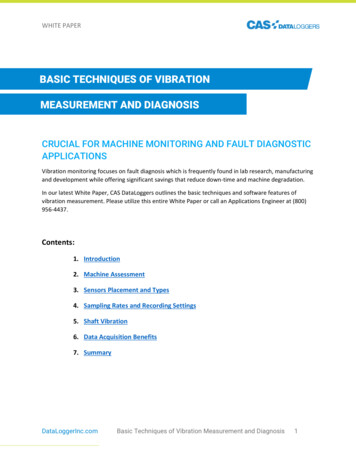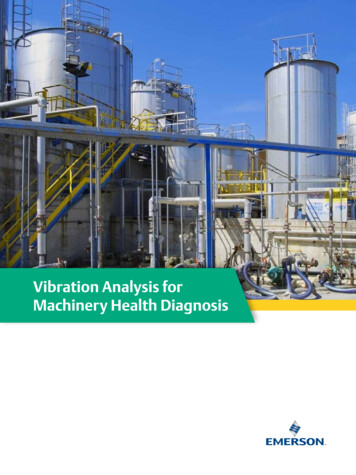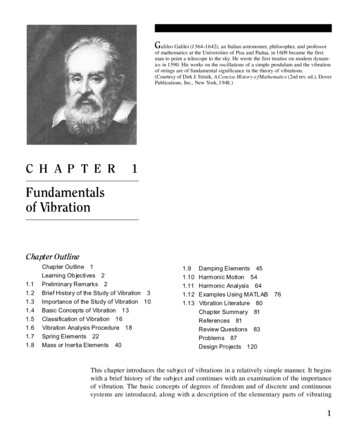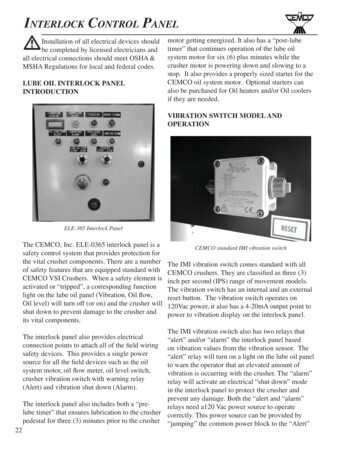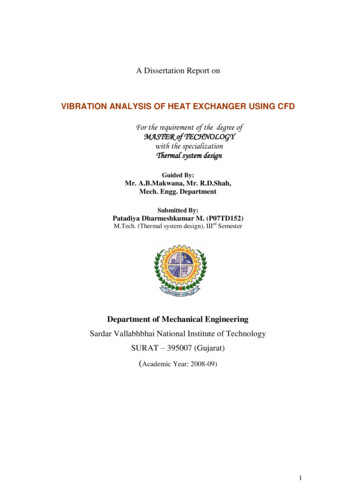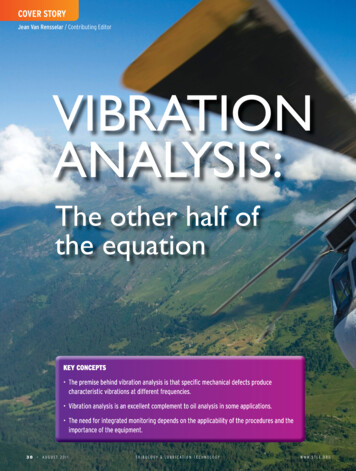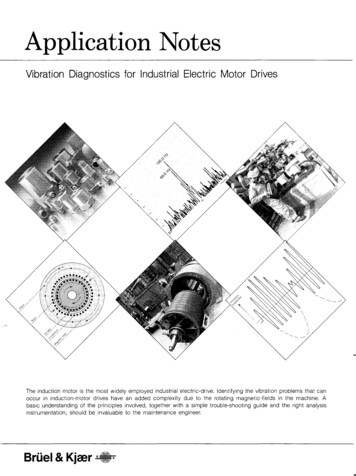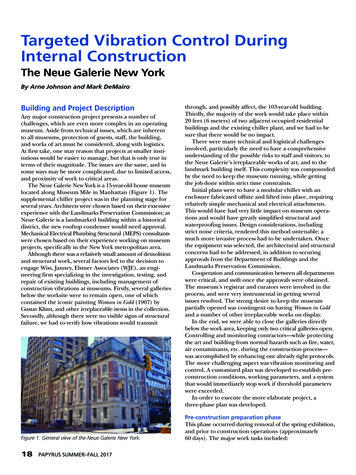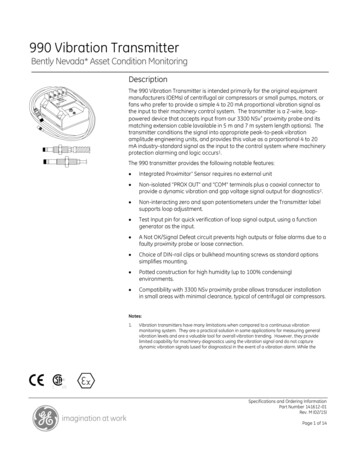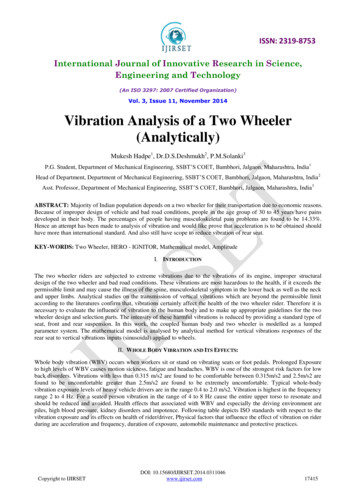
Transcription
ISSN: 2319-8753International Journal of Innovative Research in Science,Engineering and Technology(An ISO 3297: 2007 Certified Organization)Vol. 3, Issue 11, November 2014Vibration Analysis of a Two Wheeler(Analytically)Mukesh Hadpe1, Dr.D.S.Deshmukh2, P.M.Solanki3P.G. Student, Department of Mechanical Engineering, SSBT’S COET, Bambhori, Jalgaon, Maharashtra, India1Head of Department, Department of Mechanical Engineering, SSBT’S COET, Bambhori, Jalgaon, Maharashtra, India2Asst. Professor, Department of Mechanical Engineering, SSBT’S COET, Bambhori, Jalgaon, Maharashtra, India3ABSTRACT: Majority of Indian population depends on a two wheeler for their transportation due to economic reasons.Because of improper design of vehicle and bad road conditions, people in the age group of 30 to 45 years have painsdeveloped in their body. The percentages of people having musculoskeletal pain problems are found to be 14.33%.Hence an attempt has been made to analysis of vibration and would like prove that acceleration is to be obtained shouldhave more than international standard. And also still have scope to reduce vibration of rear seat.KEY-WORDS: Two Wheeler, HERO - IGNITOR, Mathematical model, AmplitudeI. INTRODUCTIONThe two wheeler riders are subjected to extreme vibrations due to the vibrations of its engine, improper structuraldesign of the two wheeler and bad road conditions. These vibrations are most hazardous to the health, if it exceeds thepermissible limit and may cause the illness of the spine, musculoskeletal symptom in the lower back as well as the neckand upper limbs. Analytical studies on the transmission of vertical vibrations which are beyond the permissible limitaccording to the literatures confirm that, vibrations certainly affect the health of the two wheeler rider. Therefore it isnecessary to evaluate the influence of vibration to the human body and to make up appropriate guidelines for the twowheeler design and selection parts. The intensity of these harmful vibrations is reduced by providing a standard type ofseat, front and rear suspension. In this work, the coupled human body and two wheeler is modelled as a lumpedparameter system. The mathematical model is analysed by analytical method for vertical vibrations responses of therear seat to vertical vibrations inputs (sinusoidal) applied to wheels.II. WHOLE BODY VIBRATION AND ITS EFFECTS:Whole body vibration (WBV) occurs when workers sit or stand on vibrating seats or foot pedals. Prolonged Exposureto high levels of WBV causes motion sickness, fatigue and headaches. WBV is one of the strongest risk factors for lowback disorders. Vibrations with less than 0.315 m/s2 are found to be comfortable between 0.315m/s2 and 2.5m/s2 arefound to be uncomfortable greater than 2.5m/s2 are found to be extremely uncomfortable. Typical whole-bodyvibration exposure levels of heavy vehicle drivers are in the range 0.4 to 2.0 m/s2. Vibration is highest in the frequencyrange 2 to 4 Hz. For a seated person vibration in the range of 4 to 8 Hz cause the entire upper torso to resonate andshould be reduced and avoided. Health effects that associated with WBV and especially the driving environment arepiles, high blood pressure, kidney disorders and impotence. Following table depicts ISO standards with respect to thevibration exposure and its effects on health of rider/driver, Physical factors that influence the effect of vibration on riderduring are acceleration and frequency, duration of exposure, automobile maintenance and protective practices.Copyright to IJIRSETDOI: 10.15680/IJIRSET.2014.0311046www.ijirset.com17415
ISSN: 2319-8753International Journal of Innovative Research in Science,Engineering and Technology(An ISO 3297: 2007 Certified Organization)Vol. 3, Issue 11, November 2014ISO STANDARDS WITH RESPECT TO THE VIBRATION EXPOSURE AND ITS EFFECTS ON HEALTH OFRIDER/DRIVER.EXPOSURE DURATION INHRSINTERNATIONAL STANDARDISO 2631-1,1997 AVERAGE RMS ACCELERATION LIMITS IN M/S2LIKELY HEALTH RISKCAUTION ZONECOMFORT LEVEL80.80.50.315120.70.40.315Table. 1. ISO standards with respect to the vibration exposure and its effects on health of rider/driver.III. METHODOLOGYThe methodology of the study is briefly summarized as follows:1. Mathematical model of two wheeler.2. Mathematical formulation of model3. Analysis of suspension system1. Mathematical model of two wheeler:Fig. 1. Shows mathematical modelling of two wheeler with equivalent spring mass system and damper2. Mathematical formulation of model: Response of a Damped system under the harmonic motion of the Base:Sometimes the base or support of spring-mass damper systems under goes harmonic motion, a shown in fig. A. Let y (t)denote the displacement of the base and x (t) denotes the displacement of mass from its static equilibrium position attime t. then the net elongation of the spring is x-y and the relative velocity between the two ends of the damper is X y . From free body diagram as shown in fig. B. we obtain the equation of motion.(A)(B)Fig. 2. Spring mass system with sinusoidal excitation (A) free body diagram (B)M X C ( X Y ) K (X Y) 0If Y (t) Y sin ωt, above equation becomesCopyright to IJIRSETDOI: 10.15680/IJIRSET.2014.0311046www.ijirset.com17416
ISSN: 2319-8753International Journal of Innovative Research in Science,Engineering and Technology(An ISO 3297: 2007 Certified Organization)Vol. 3, Issue 11, November 2014M X C X 𝐾 𝑋 𝐾 Y sin ωt 𝐶ω Y cos ωt A sin (ωt α)CωWhere A Y (Cω)2 and α tan 1 ( ). This shows that giving excitation to the base is equivalent toKapplying a harmonic force of magnitude A to the mass. By using the solution indicated by equation, the steady state ofresponse the massXP (t) can be expressed asK2Y K 2 (C ω )2XP t Sin (ωt Ø1 α)(K M ω2 )2 (C ω)2CωWhere Ø1 tan 1K Mω2Using trigonometry identities, above equation can be written as more convenient from asXP t X Sin (ωt Ø )Where X and Ø are given byXY K 2 (Cω )2(K Mω2 )2 (Cω)2Ø tan 112 MC ω3K K Mω 2 ω C 211 (2εr )22(1 r 2 )2 (2εr)2 tan 12εr 31 (4ε 2 1)r 2The ratio of the amplitude of the response XP t to that of base of motion Y (t) is called the displacementXtransmissibility. The variation of Td and Ø given by above equation.YFig. 3. Shows comparison of frequency ratio and displacement transmissibility, frequency ratio and phase angleIV. ANALYSIS OF SUSPENSION SYSTEMAssumption of a simple model of motor vehicle as a Hero –Igniter bike that can vibrate in the vertical direction whiletravelling over rough road. Vehicle has mass of 129 kg (including weight of passenger). The suspension system has aspring constant of 15.28 103 N/M (Calculated by online spring stiffness calculator) and a damping ratio of ε 2.70 for vehicle speed 20, 40, 60 Km/Hr .the road surface varies sinusoidal with a amplitude of Y 0.05 m andwavelength here I consider 6 m,Spring Stiffness calculation: as on the basis of dimensions measured from shock absorberWire diameter (d) 7 mm, No of active coils (n) 15, Outer diameter of spring coil 54 mm, Mean diameter of springcoil 47 mm, Force on spring 1265.49 N.Copyright to IJIRSETDOI: 10.15680/IJIRSET.2014.0311046www.ijirset.com17417
ISSN: 2319-8753International Journal of Innovative Research in Science,Engineering and Technology(An ISO 3297: 2007 Certified Organization)Vol. 3, Issue 11, November 2014Table.2. Shows stiffness calculator with results for stiffness of spring and required dimension.Damping ratio calculation:Damping coefficient (c) Damping ratio (ε) CCcF 4049.57 Ns m , Critical damping constant (Cc ) 2m K m or 2mω 1501.57.X 2.70The frequency, ω 2πf 2πv 1000136006 0.290889 v rad/secFor v1 20 Km/Hr, ω 5.81778 rad/sec,For v2 40 Km/Hr, ω 11.6355 rad/sec,For v3 60 Km/Hr, ω 17.4532 rad/sec,The natural frequency of vehicle is given by:ωn K M15.28 10 312129 10.89 rad/secAnd hence frequency ratio r is:(r)20 Km /Hr (r)40 Km /Hr ωωnωωn 5.8177810.8911.635510.89Copyright to IJIRSET 0.54 1.068DOI: 10.15680/IJIRSET.2014.0311046www.ijirset.com17418
ISSN: 2319-8753International Journal of Innovative Research in Science,Engineering and Technology(An ISO 3297: 2007 Certified Organization)Vol. 3, Issue 11, November 2014The amplitude ratio can be found as:X1Y 20 Km/HrX1Y20 Km /Hr K2 (Cω )212 2(K Mω2 ) (Cω)21 (2εr )212(1 r 2 )2 (2εr)2 1 (2 2.70 0.54 )212(1 (0.54)2 )2 (2 2.70 0.54)2 1.027.Thus the displacement amplitude of vehicle at different road amplitude is given by:X1 1.027 0.05 0.052 m.X1 1.027 0.10 0.11 m.X1 1.027 0.15 0.16 m.X1 1.027 0.20 0.21 m.X1 A ω cos ω t 0.32 m/s, at time period t 2π ω 1.079 sec.X1 A ω cos ω t 0.63 m/s, at time period t 2π ω 1.079 sec.X1 A ω cos ω t 0.94 m/s, at time period t 2π ω 1.079 sec.𝑋1 A ω cos ω t 1.25 m/s, at time period 𝑡 2𝜋 ω 1.079 sec.X1 ω 2 x1 1.77 m s 2X1 ω 2 x1 3.73 m s 2X1 ω 2 x1 5.41 m s 2X1 ω 2 x1 7.11 m s 2𝑋2𝑌40 𝐾𝑚 /𝐻𝑟X2Y40 Km /Hr 𝐾 2 (𝐶ω )2(𝐾 𝑀ω2 )2 (𝐶ω)212 1 (2𝜀𝑟 )2(1 𝑟 2 )2 (2𝜀𝑟 )212 1 (2 2.70 1.068 )212(1 (1.068 )2 )2 (2 2.70 1.068 )2 5.77.Thus the displacement amplitude of vehicle at different road amplitude is given by:X2 5.77 0.05 0.29 m.X2 5.77 0.10 0.58 m.X2 5.77 0.15 0.87 m.X2 5.77 0.20 1.54 m.X 2 (0.05) ω cos ω t 0.31 m/s, at time period t 2π ω 0.54 sec.X 2 (0.10) ω cos ω t 0.62 m/s, at time period t 2π ω 0.54 sec.X 2 (0.15) ω cos ω t 0.93 m/s, at time period t 2π ω 0.54 sec.Copyright to IJIRSETDOI: 10.15680/IJIRSET.2014.0311046www.ijirset.com17419
ISSN: 2319-8753International Journal of Innovative Research in Science,Engineering and Technology(An ISO 3297: 2007 Certified Organization)Vol. 3, Issue 11, November 2014X 2 (0.20) ω cos ω t 1.24 m/s, at time period t 2π ω 0.54 sec.X 2 ω 2 x2 39.29 m s 2X 2 ω 2 x2 78.58 m s 2X 2 ω 2 x2 117.88 m s 2𝑋2 ω 2 x2 208.65 𝑚 𝑠 2V. RESULT AND DISCUSSIONThe acceleration is to be measured with assumption of different road condition and at two speedsIn following table.SpeedRoad OneRoad TwoRoad ThreeRoad Four(Km/Hr)(0.05 m/s2)(0.10 m/s2)(0.15 m/s2)(0.20 le.3. Shows results of acceleration is to be measured with assumption of different road condition and at two speedsAlong with that graphical representation of comparison between speed, vehicle acceleration and road roughness.A 250c200ce i 150l o100e nr50a0t208.65117.8840 Km/Hr78.5820 Km/Hr39.291.773.735.417.110.050.10.150.2Road AmplitudeFig. 4. Shows comparison between road amplitude and acceleration.From Analytical analysis it was observed that as amplitude of road or road roughness raises acceleration mayalso going to be rise. Here through graph we can observe that acceleration is to be occurring is more thancomfort level or as per international standard notified in above table.VI. CONCLUSIONAcceleration because of is a physical disturbance that occurs in vehicles. The nature of vibration present in avehicle depends upon the dynamic characteristics of the two wheeler and road surface characters. Its effect onCopyright to IJIRSETDOI: 10.15680/IJIRSET.2014.0311046www.ijirset.com17420
ISSN: 2319-8753International Journal of Innovative Research in Science,Engineering and Technology(An ISO 3297: 2007 Certified Organization)Vol. 3, Issue 11, November 2014the human body depends mainly on the acceleration, frequency, magnitude, direction of vibration, area ofcontact and duration of exposure. Exposure to human body will result in transmission of vibratory energy to theentire body and leads to localized effect. It affects comfort, normal functioning of body and health. Exposure tocertain frequencies of vibration may have effects on specific segment of the body. From the results it is foundthat, for the given acceleration of two wheeler and human body the ideal operating conditions is more thancomfort level that is mean above 0.315 m/s2 or above total acceleration i.e. 0.8 m/s2 as a safety standard levelof vibration. So from above analysis we may going to conclude that as rise of speed or amplitude may vary thatshould directly affected to acceleration of body, hence still we have scope to redesign of shock absorber toreduce vibration as [11]Bridger R S “Introduction to Ergonomics,” McGraw-hill International editions, 1995, pp. 318-349.S. M Mirbod et al. “Assessment of Hand-Arm Vibration exposure among Traffic police motorcyclists,” International Archives ofoccupational and Environmental health Vol. 70, 1997, pp. 22-28.J. C Chent, J.T Dennerlein, L.M Ryan, “Predictors of whole-body vibration levels among urban taxi drivers,” Ergonomics, Vol. 46, 2003,pp-1075-1090.R. R. Coermann, “The mechanical impedance of the human body in sitting and standing position at low frequencies. Human Factor s”,October 1962, pp. 227–253.Mothira K. Patil, M.S. Palanichamy, Dhanjo N. Ghista, “Minimization of Tractor-Occupant's Traumatic Vibration Response by Means ofthe “Patil-Palanichamy - Ghista” (PPG) Tractor Seat Suspension,” Studies in Environmental Science, Vol.13, 1981, pp.364-371.Farid M. L. mirouche, “Modelling of Human Reactions to Whole-Body Vibration,” Journal of Biomechanical Engineering, Vol.3, 1987, pp.210-217.Hedrick, J. K., “Nonlinear control of a Quarter Car active suspension”, Proceedings of the American Control Conference, Chica go, June1992Majjad, R., “Estimation of suspension parameters”, Proceedings of the IEEE International Conference on Control Application, Hartford,October 1997.Gobbi, M. and Mastinu, G.,“Analytical description and optimization of the dynamic behaviour of passively suspended road vehicle s”,Journal of Sound and Vibration, Vol. 245, No.3, pp. 457 –481, 2001.Rajalingam, C. and Rakheja, S., “Influence of suspension damper asymmetry on vehicle vibration response to ground excitation”, Journal ofSound and Vibration, Vol. 266, pp.1117 –1129, 2003.Ahmad Faheem, Firoz Alam, and Varikan Thomas, “The suspension dynamic analysis for a quarter car model and half car model”, 3 rdBSME-ASME International Conference on Thermal Engineering, Dhaka, December 2006Copyright to IJIRSETDOI: 10.15680/IJIRSET.2014.0311046www.ijirset.com17421
vibration exposure levels of heavy vehicle drivers are in the range 0.4 to 2.0 m/s2. Vibration is highest in the frequency range 2 to 4 Hz. For a seated person vibration in the range of 4 to 8 Hz cause the entire upper torso to resonate and should be reduced and avoided.
